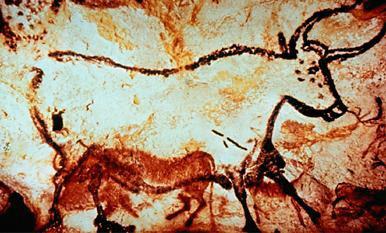
In your reading, you were introduced to the history of filmmaking technology and were given a taste of the evolution of this vast topic. Before we dig into the inner workings of a camera or the technology of sound recording, however, let’s take a step back. We’ll ease into the basic technology of film slowly. First, in this lesson, we’ll spend a little time discussing the theory of recorded media.
Recording: The Birth of the Entertainment Matrix
Recording has changed our world. Indeed, it is not too much to say that photography and sound recording have created a new world, patently longer lasting than the "real" world which serves sometimes as its subject matter, and certainly more artistic.
 |
||
| The act of telling stories through pictures dates back perhaps 30,000 years, to the cave paintings in Lascaux, France. | ||
Imagine a world without any artificial images or sounds. You’d have to go back 30,000 years or more to get to that state. In this old world, now long gone, everything is real, everything is now. What you see, is.
But not for long. The urge to re-create the real world seems ingrained in our DNA. It appears that as soon as we learned to speak, we tried to reproduce what we saw and heard. The cave paintings at Lascaux are perhaps 30,000 years old, and thus antedate by tens of thousands of years the invention of writing. Even without the benefit of writing, though, it is clear we were telling stories almost since the beginning of speech.
Why were we telling these stories? To entertain ourselves, certainly, but also to pass along vital information. The "entertainment matrix," the system of creating and sharing media-based stories for our own entertainment and education, had been born.
It is a basic human urge—and one that is unique to the human species—to try to capture images, sounds, and stories, to record them as evidence of our times and to pass them on to others. But for at least the first 29,900 years since those cave paintings were executed, we were limited to capturing these images and sounds through human, artificial talent. If you wanted a picture, you had to paint it. If you wanted to duplicate a sound, you needed to construct a musical instrument and learn how to play it.
It is only in the last 170 years that we have had technologies to reproduce images and sounds more or less automatically without the intervention of human artistic talent. The basic concept of the camera obscura had been known for a long time before the invention of photography in the 1830s. The basic technology necessary for recording real sounds had been around for 500 years before Edison put those elements together in a practical device in the 1870s. The device he invented for recording and playing back sounds, the phonograph, was entirely mechanical: no electricity necessary. (A good clockmaker could have figured this out in the 1400s.)
Once sound recording and cinema were available to artists, the entertainment matrix quickly reached a new level. What had been an occasional sharing of stories (a Christmas pageant, an Easter play, a midsummer night’s festival) now became constant.
Very rapidly, these separate technologies began to interact. The result was motion pictures. But the earliest movies were the result of chemical and mechanical inventions. (They relied on optics, too, but nothing new had to be invented there.) On a separate track, we were learning how to use electricity to capture and transmit images and sounds. The two streams soon came together. By 1929, movies and radio were ready to combine.
But there was a third element in the eventual media mix: digitization. While digital ideas had been kicking around in the early part of the 20th century, it wasn’t until the last quarter of the 1900s that digitization became an integral part of the media mix. In some ways, the move from analog to digital was as important as the development of recording itself. Because the digital record of an image or a sound was abstracted to a more basic level, it allowed much more manipulation while, at the same time, being preserved more accurately and easily.
So we can see three stages in the evolution of human media:
You may want to divide stage three into two parts—analog and digital—but since the digital world is still being developed, it may be too soon to see how this difference in recording techniques affects us. (We’ll examine this idea more closely in just a moment.)
In any event, our stage three world is entirely different from the human experience that went before it. Now, all of us spend a good part of our waking hours "in the media," so we had better understand how it operates.